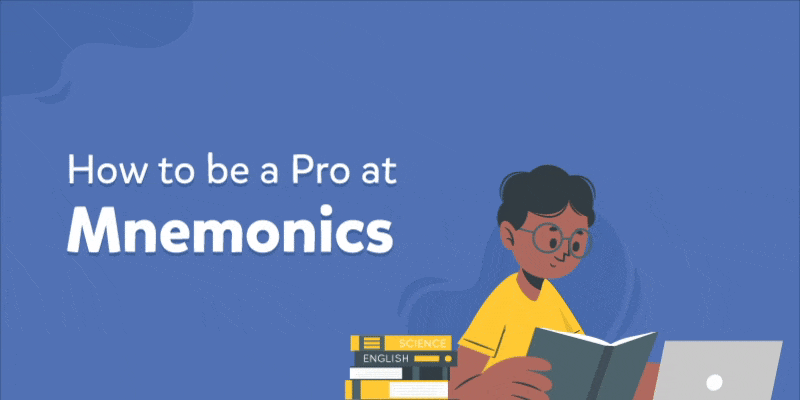
Remember the time when you struggled with tricky spelling or a complex trigonometric formula? What did you do then? After multiple attempts of re-reading and trying to memorise, you found a way to remember it – either by repeating the spelling repeatedly or by connecting it with something else. Both these methods helped you to remember it better and for a longer time. Pretty amazing, isn’t it?
Our brain works in a tricky way and, at times, it requires a certain push to remember and recall certain things. While it is true that understanding is always better than memorising, sometimes you will need a few tricks to help your brain remember better. And that’s where the application of mnemonic tricks comes into play.
Mnemonics are memory aids that help you remember something, whether it’s simple or difficult. They are more like learning techniques that boost your memory and help you remember things more efficiently.
Here is a simple example:

Visual mnemonics to differentiate between ‘there’ and ‘their’
You know that the meaning of ‘there’ is ‘opposite of here’ and the meaning of ‘their’ is ‘something that belongs to them’. Recall your childhood days when you were first introduced to these two words and the time you took to differentiate them. What method(s) did you use to identify ‘there’ and ‘their’? And did all hell break loose when another word ‘they’re’ was added to that list?
Mnemonics can come in various forms, such as a song, rhyme, acronym, image, phrase, or even sentence! These techniques are more particularly effective in recalling and retaining facts, spellings, a list or the order of a list. And the best part, you can try out these learning techniques at any age (even when you are 50 years old!).
Well, you will be surprised to know how frequently and in different ways you use mnemonics in your everyday lives. From remembering tricky mathematics formulas to tables and orders on a list, you use it in almost everything.
For instance, while remembering the periodic table and element’s order, you could use mnemonics like this:

Mnemonic tricks to remember the periodic table
Some mnemonics are widely used and have stood the test of time, such as ‘My very eager mother just served us nine pizzas’. Can you guess what that’s for? It’s used to remember the names and order of the planets in our solar system. As you can see, there are nine words that stand for nine planets and the ‘p’ stood for Pluto. Of course, now there are only eight planets and Pluto is considered to be a dwarf planet.
But mnemonics tend to work more effectively if they have some sort of personal meaning attached to them. This means mnemonic tricks are not standard tricks and if you can think of a link that works for you, no matter how random it may seem, then it works. All you need is an imagination.
Rhyme
Rhyme is one of the most popular methods of mnemonics that uses the part of the brain that responds to rhythm and music (the same part of the brain that helps you remember song lyrics!)
For instance, a rhyme to help with a common spelling confusion: ‘I before E, except after C, or when sounding like A’, like in neighbour and weight.
Acrostics
An acrostic is when you make a sentence out of the first letter of each word in a sequence to make it more memorable. For example – ‘Never Eat Shredded Wheat’ is an acrostic mnemonics for the points of the compass or ‘King Henry Died Drinking Chocolate Milk’, which corresponds to kilo, hecto, deca, deci, centi, and milli in the metric system. VIBGYOR is another such example (you know what it stands for, don’t you?)
Chunking numbers the right way
Ever wondered how adults remember so many phone numbers, security codes and addresses? You will not be surprised to learn that they use the mnemonic device call ‘chunking’. Chunking is a mnemonic strategy that helps organise information into more easily learned groups, phrases, words, or numbers. For instance, the number 789532846344 will probably take a fair amount of effort to remember. However, if it is chunked like 7895 3284 6344, it becomes relatively easier to remember.
Memory picture
Many people are visual learners, that is, they remember better when linked with a picture or a video. With memory mnemonics, you have the freedom to explore endlessly and link things that make sense to you and help you remember. For example, while remembering the number of days in each month, you can use the knuckle method.

A mnemonic using your knuckles to remember the months of the year
The best part of making great mnemonics is that there is no right or wrong way. All you need is a connection and a bit of imagination that would help you remember easily.
Here’s how:
Tip: Keep the mnemonic device simple so that it is easy for you to relate and remember in order. Don’t worry if the story or the sentence that you created makes little sense—if you remember it, go with it!
Read More:
Books are Tanaya Goswami’s first love and cheesecakes come a close second. Talking about movies, music, calligraphy, politics, and Elon Musk will get you listed under the friends’ section of her diary. Ever since moving on from her job as an English lecturer, she spends her time at BYJU’S crafting stories filled with emotion and sprinkled with sarcasm. Outside of work, she’s either learning something new (French, most recently!) or is curled up with a book and a cup of coffee. She firmly believes that discovering what you don’t know is the key to knowledge and is constantly working towards improving herself. Drop in a line at storyweavers@byjus.com if you liked her stories, have something nice to say, or if you have compelling ideas to share!